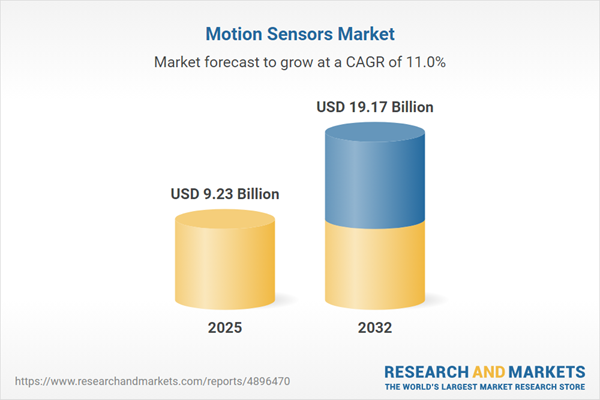Speak directly to the analyst to clarify any post sales queries you may have.
The motion sensor market is rapidly transforming how enterprises approach automation, sustainability, and operational excellence. Driven by the integration of advanced sensor technologies into smart buildings and industrial systems, these devices enable data-driven decisions and adaptive controls within connected environments.
Market Snapshot: Motion Sensors Market Growth and Opportunity
The Motion Sensors Market grew from USD 8.31 billion in 2024 to USD 9.23 billion in 2025 and is projected to reach USD 19.17 billion by 2032, registering a CAGR of 11.01%. Demand is fueled by the convergence of intelligent buildings, regulatory shifts in energy management, and growing prioritization of data security. Adoption is strong across commercial, industrial, and residential verticals, with significant investments seen in automation, contactless interactions, and analytics-driven facility management.
Scope & Segmentation
- Technology Types: Dual-technology, microwave, passive infrared, tomographic, ultrasonic, vibration, video image processing
- Installation Environments: Indoor, outdoor
- Mounting Styles: Ceiling, floor, portable, wall
- Product Types: Detector, switch
- Output Types: Analog, digital
- Application Areas: Energy management, HVAC control, lighting control, occupancy analytics, security systems (including access control, intrusion detection, perimeter security)
- End-User Industries: Commercial (hospitality, offices, retail stores), industrial (manufacturing, oil and gas), residential
- Geographical Regions: Americas (North America, Latin America), Europe, Middle East, Africa, Asia-Pacific
Within these segments, dual-technology and video analytics solutions are vital in security systems, while energy management and smart home integrations drive uptake in commercial and residential spaces. Regional heterogeneity reflects differing regulations, infrastructure maturity, and market adaptability across the Americas, EMEA, and Asia-Pacific markets.
Key Takeaways: Strategic Insights for Decision-Makers
- Artificial intelligence and edge computing within sensor modules enhance real-time analytics and predictive automation capabilities.
- Wireless protocols such as Zigbee and 5G improve scalability and simplify large-scale deployment in smart buildings and industrial plants.
- Sensor miniaturization and energy harvesting support sustainability goals and lower long-term maintenance costs, aligning with green certification requirements.
- Strong cybersecurity measures, including encryption and secure firmware updates, are essential to protect critical data in connected environments.
- Market participants are increasingly adopting modular, reconfigurable designs to address changing health and safety requirements.
- The interplay of industry partnerships, government standards, and open architecture drives faster adoption and interoperability in diverse settings.
Tariff Impact: Navigating Supply Chain Complexity
Forthcoming United States tariff revisions for key electronic components are prompting motion sensor manufacturers to reassess sourcing, production, and supply chain configurations. Companies are mitigating risks by relocating manufacturing closer to end-user markets, increasing buffer stocks, and securing long-term supply agreements. Industry stakeholders are also re-engineering product designs for component substitution and actively engaging in scenario planning using digital supply chain visibility tools to ensure continuity.
Methodology & Data Sources
This report applies a structured research process, synthesizing secondary sources including technical white papers, industry journals, and patent databases. These insights are qualified by primary interviews with senior executives, engineers, and procurement leaders. Quantitative and qualitative analyses are verified with industry stakeholders and cross-checked by regional and domain specialists to ensure validity and transparency.
Why This Report Matters
- Delivers actionable intelligence for strategic planning amid rapid technological advances and emerging regulatory challenges.
- Enables risk-aware decision-making through in-depth analysis of tariff impacts, supply chain resilience, and competitive positioning.
- Equips leaders with clarity on key technologies and regional market dynamics essential for long-term growth and innovation.
Conclusion
The motion sensors market is advancing as organizations pursue automation, sustainability, and operational resilience. Success will depend on leveraging intelligent technologies, robust supply strategies, and adaptive solutions tailored to market and regulatory realities.
Additional Product Information:
- Purchase of this report includes 1 year online access with quarterly updates.
- This report can be updated on request. Please contact our Customer Experience team using the Ask a Question widget on our website.
Table of Contents
3. Executive Summary
4. Market Overview
7. Cumulative Impact of Artificial Intelligence 2025
Companies Mentioned
The companies profiled in this Motion Sensors market report include:- STMicroelectronics N.V.
- Murata Manufacturing Co., Ltd.
- Robert Bosch GmbH
- TDK Corporation
- Analog Devices, Inc.
- Texas Instruments Incorporated
- NXP Semiconductors N.V.
- Qualcomm Incorporated
- Knowles Corporation
- Broadcom Inc.
Table Information
| Report Attribute | Details |
|---|---|
| No. of Pages | 184 |
| Published | October 2025 |
| Forecast Period | 2025 - 2032 |
| Estimated Market Value ( USD | $ 9.23 Billion |
| Forecasted Market Value ( USD | $ 19.17 Billion |
| Compound Annual Growth Rate | 11.0% |
| Regions Covered | Global |
| No. of Companies Mentioned | 11 |









